Trisha Mittal
Model-agnostic Coreset Selection via LLM-based Concept Bottlenecks
Feb 23, 2025Abstract:Coreset Selection (CS) identifies a subset of training data that achieves model performance comparable to using the entire dataset. Many state-of-the-art CS methods, select coresets using scores whose computation requires training the downstream model on the entire dataset and recording changes in its behavior on samples as it trains (training dynamics). These scores are inefficient to compute and hard to interpret as they do not indicate whether a sample is difficult to learn in general or only for a specific model. Our work addresses these challenges by proposing an interpretable score that gauges a sample's difficulty using human-understandable textual attributes (concepts) independent of any downstream model. Specifically, we measure the alignment between a sample's visual features and concept bottlenecks, derived via large language models, by training a linear concept bottleneck layer and compute the sample's difficulty score using it. We then use this score and a stratified sampling strategy to identify the coreset. Crucially, our score is efficiently computable without training the downstream model on the full dataset even once, leads to high-performing coresets for various downstream models, and is computable even for an unlabeled dataset. Through experiments on CIFAR-10, CIFAR-100, and ImageNet-1K, we show our coresets outperform random subsets, even at high pruning rates, and achieve model performance comparable to or better than coresets found by training dynamics-based methods.
Naturalistic Head Motion Generation from Speech
Oct 26, 2022



Abstract:Synthesizing natural head motion to accompany speech for an embodied conversational agent is necessary for providing a rich interactive experience. Most prior works assess the quality of generated head motion by comparing them against a single ground-truth using an objective metric. Yet there are many plausible head motion sequences to accompany a speech utterance. In this work, we study the variation in the perceptual quality of head motions sampled from a generative model. We show that, despite providing more diverse head motions, the generative model produces motions with varying degrees of perceptual quality. We finally show that objective metrics commonly used in previous research do not accurately reflect the perceptual quality of generated head motions. These results open an interesting avenue for future work to investigate better objective metrics that correlate with human perception of quality.
Video Manipulations Beyond Faces: A Dataset with Human-Machine Analysis
Jul 27, 2022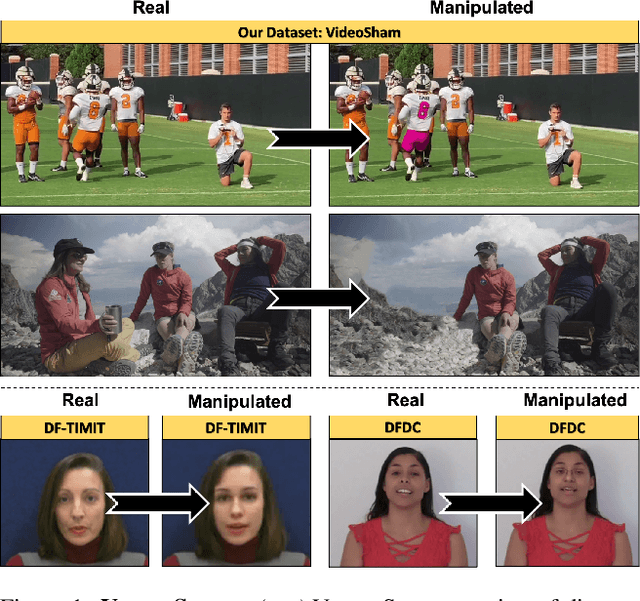


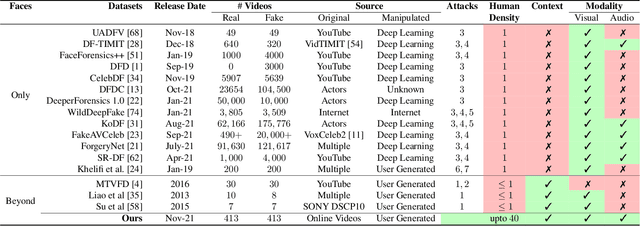
Abstract:As tools for content editing mature, and artificial intelligence (AI) based algorithms for synthesizing media grow, the presence of manipulated content across online media is increasing. This phenomenon causes the spread of misinformation, creating a greater need to distinguish between "real" and "manipulated" content. To this end, we present VideoSham, a dataset consisting of 826 videos (413 real and 413 manipulated). Many of the existing deepfake datasets focus exclusively on two types of facial manipulations -- swapping with a different subject's face or altering the existing face. VideoSham, on the other hand, contains more diverse, context-rich, and human-centric, high-resolution videos manipulated using a combination of 6 different spatial and temporal attacks. Our analysis shows that state-of-the-art manipulation detection algorithms only work for a few specific attacks and do not scale well on VideoSham. We performed a user study on Amazon Mechanical Turk with 1200 participants to understand if they can differentiate between the real and manipulated videos in VideoSham. Finally, we dig deeper into the strengths and weaknesses of performances by humans and SOTA-algorithms to identify gaps that need to be filled with better AI algorithms.
3MASSIV: Multilingual, Multimodal and Multi-Aspect dataset of Social Media Short Videos
Mar 28, 2022



Abstract:We present 3MASSIV, a multilingual, multimodal and multi-aspect, expertly-annotated dataset of diverse short videos extracted from short-video social media platform - Moj. 3MASSIV comprises of 50k short videos (20 seconds average duration) and 100K unlabeled videos in 11 different languages and captures popular short video trends like pranks, fails, romance, comedy expressed via unique audio-visual formats like self-shot videos, reaction videos, lip-synching, self-sung songs, etc. 3MASSIV presents an opportunity for multimodal and multilingual semantic understanding on these unique videos by annotating them for concepts, affective states, media types, and audio language. We present a thorough analysis of 3MASSIV and highlight the variety and unique aspects of our dataset compared to other contemporary popular datasets with strong baselines. We also show how the social media content in 3MASSIV is dynamic and temporal in nature, which can be used for semantic understanding tasks and cross-lingual analysis.
Affect2MM: Affective Analysis of Multimedia Content Using Emotion Causality
Mar 11, 2021



Abstract:We present Affect2MM, a learning method for time-series emotion prediction for multimedia content. Our goal is to automatically capture the varying emotions depicted by characters in real-life human-centric situations and behaviors. We use the ideas from emotion causation theories to computationally model and determine the emotional state evoked in clips of movies. Affect2MM explicitly models the temporal causality using attention-based methods and Granger causality. We use a variety of components like facial features of actors involved, scene understanding, visual aesthetics, action/situation description, and movie script to obtain an affective-rich representation to understand and perceive the scene. We use an LSTM-based learning model for emotion perception. To evaluate our method, we analyze and compare our performance on three datasets, SENDv1, MovieGraphs, and the LIRIS-ACCEDE dataset, and observe an average of 10-15% increase in the performance over SOTA methods for all three datasets.
Dynamic Graph Modeling of Simultaneous EEG and Eye-tracking Data for Reading Task Identification
Feb 21, 2021
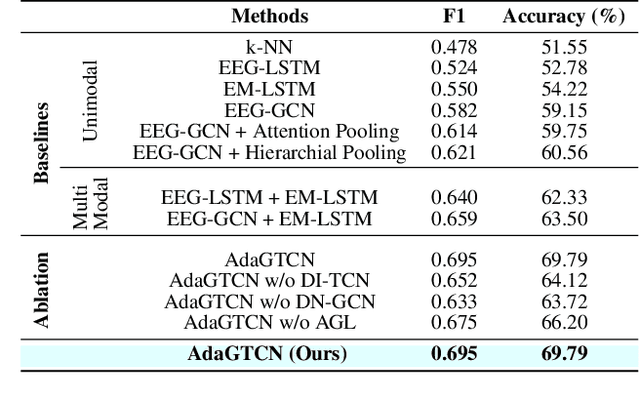

Abstract:We present a new approach, that we call AdaGTCN, for identifying human reader intent from Electroencephalogram~(EEG) and Eye movement~(EM) data in order to help differentiate between normal reading and task-oriented reading. Understanding the physiological aspects of the reading process~(the cognitive load and the reading intent) can help improve the quality of crowd-sourced annotated data. Our method, Adaptive Graph Temporal Convolution Network (AdaGTCN), uses an Adaptive Graph Learning Layer and Deep Neighborhood Graph Convolution Layer for identifying the reading activities using time-locked EEG sequences recorded during word-level eye-movement fixations. Adaptive Graph Learning Layer dynamically learns the spatial correlations between the EEG electrode signals while the Deep Neighborhood Graph Convolution Layer exploits temporal features from a dense graph neighborhood to establish the state of the art in reading task identification over other contemporary approaches. We compare our approach with several baselines to report an improvement of 6.29% on the ZuCo 2.0 dataset, along with extensive ablation experiments
MCQA: Multimodal Co-attention Based Network for Question Answering
Apr 25, 2020
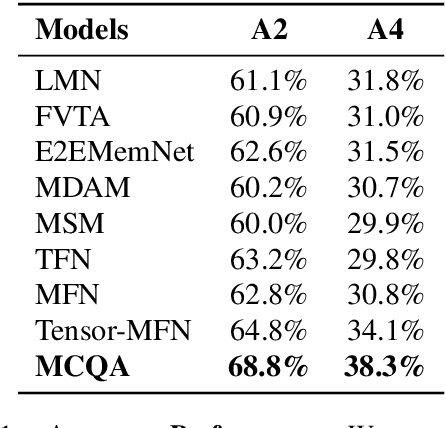
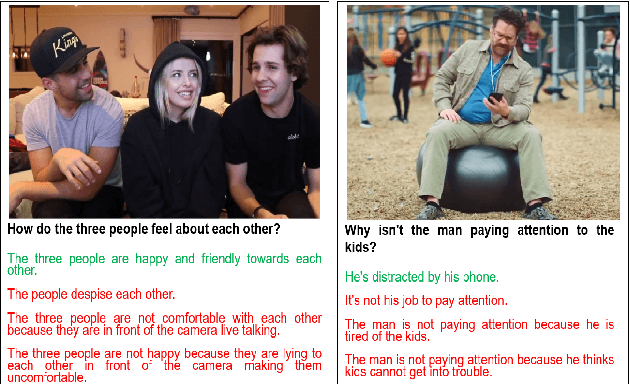
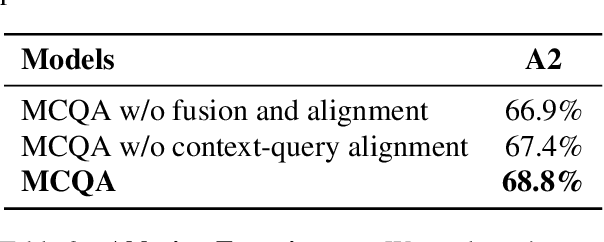
Abstract:We present MCQA, a learning-based algorithm for multimodal question answering. MCQA explicitly fuses and aligns the multimodal input (i.e. text, audio, and video), which forms the context for the query (question and answer). Our approach fuses and aligns the question and the answer within this context. Moreover, we use the notion of co-attention to perform cross-modal alignment and multimodal context-query alignment. Our context-query alignment module matches the relevant parts of the multimodal context and the query with each other and aligns them to improve the overall performance. We evaluate the performance of MCQA on Social-IQ, a benchmark dataset for multimodal question answering. We compare the performance of our algorithm with prior methods and observe an accuracy improvement of 4-7%.
Emotions Don't Lie: A Deepfake Detection Method using Audio-Visual Affective Cues
Mar 17, 2020

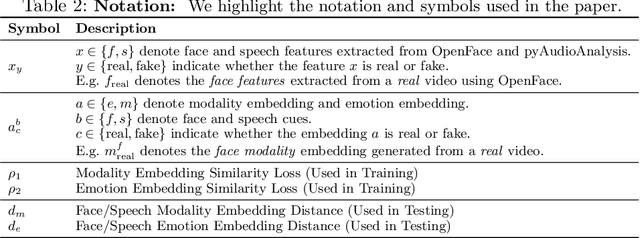

Abstract:We present a learning-based multimodal method for detecting real and deepfake videos. To maximize information for learning, we extract and analyze the similarity between the two audio and visual modalities from within the same video. Additionally, we extract and compare affective cues corresponding to emotion from the two modalities within a video to infer whether the input video is "real" or "fake". We propose a deep learning network, inspired by the Siamese network architecture and the triplet loss. To validate our model, we report the AUC metric on two large-scale, audio-visual deepfake detection datasets, DeepFake-TIMIT Dataset and DFDC. We compare our approach with several SOTA deepfake detection methods and report per-video AUC of 84.4% on the DFDC and 96.6% on the DF-TIMIT datasets, respectively.
EmotiCon: Context-Aware Multimodal Emotion Recognition using Frege's Principle
Mar 14, 2020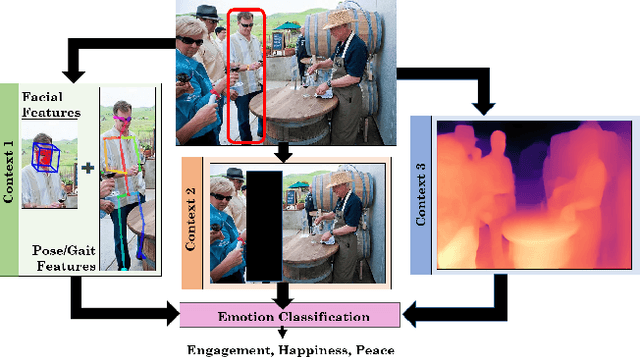

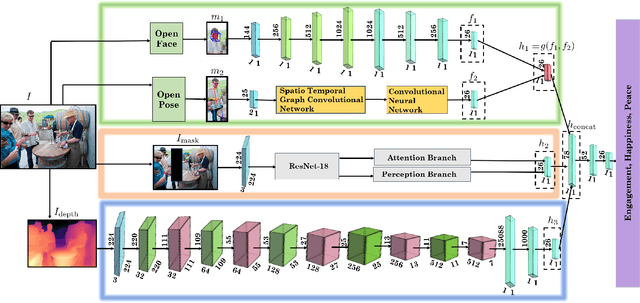
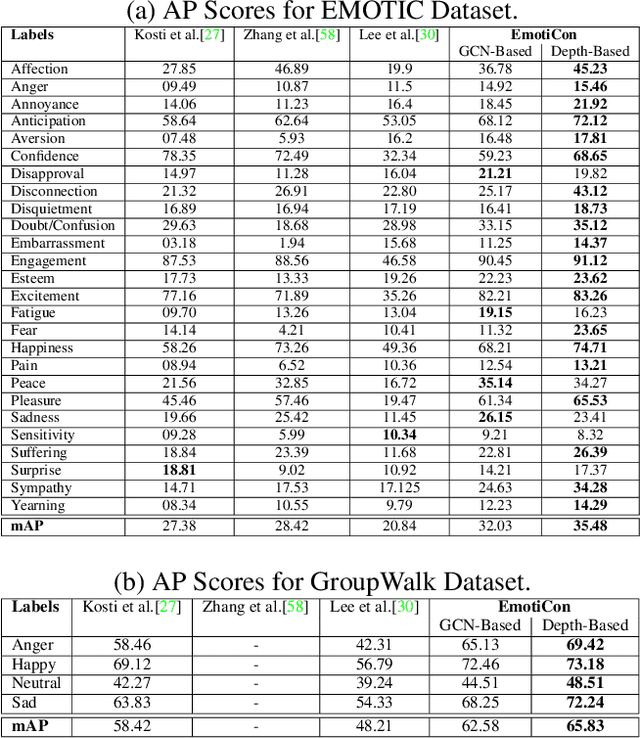
Abstract:We present EmotiCon, a learning-based algorithm for context-aware perceived human emotion recognition from videos and images. Motivated by Frege's Context Principle from psychology, our approach combines three interpretations of context for emotion recognition. Our first interpretation is based on using multiple modalities(e.g. faces and gaits) for emotion recognition. For the second interpretation, we gather semantic context from the input image and use a self-attention-based CNN to encode this information. Finally, we use depth maps to model the third interpretation related to socio-dynamic interactions and proximity among agents. We demonstrate the efficiency of our network through experiments on EMOTIC, a benchmark dataset. We report an Average Precision (AP) score of 35.48 across 26 classes, which is an improvement of 7-8 over prior methods. We also introduce a new dataset, GroupWalk, which is a collection of videos captured in multiple real-world settings of people walking. We report an AP of 65.83 across 4 categories on GroupWalk, which is also an improvement over prior methods.
CMetric: A Driving Behavior Measure Using Centrality Functions
Mar 09, 2020



Abstract:We present a new measure, CMetric, to classify driver behaviors using centrality functions. Our formulation combines concepts from computational graph theory and social traffic psychology to quantify and classify the behavior of human drivers. CMetric is used to compute the probability of a vehicle executing a driving style, as well as the intensity used to execute the style. Our approach is designed for realtime autonomous driving applications, where the trajectory of each vehicle or road-agent is extracted from a video. We compute a dynamic geometric graph (DGG) based on the positions and proximity of the road-agents and centrality functions corresponding to closeness and degree. These functions are used to compute the CMetric based on style likelihood and style intensity estimates. Our approach is general and makes no assumption about traffic density, heterogeneity, or how driving behaviors change over time. We present efficient techniques to compute CMetric and demonstrate its performance on well-known autonomous driving datasets. We evaluate the accuracy of CMetric and compare with ground truth behavior labels and with that of a human observer by performing a user study over over a long vehicle trajectory.
 Add to Chrome
Add to Chrome Add to Firefox
Add to Firefox Add to Edge
Add to Edge